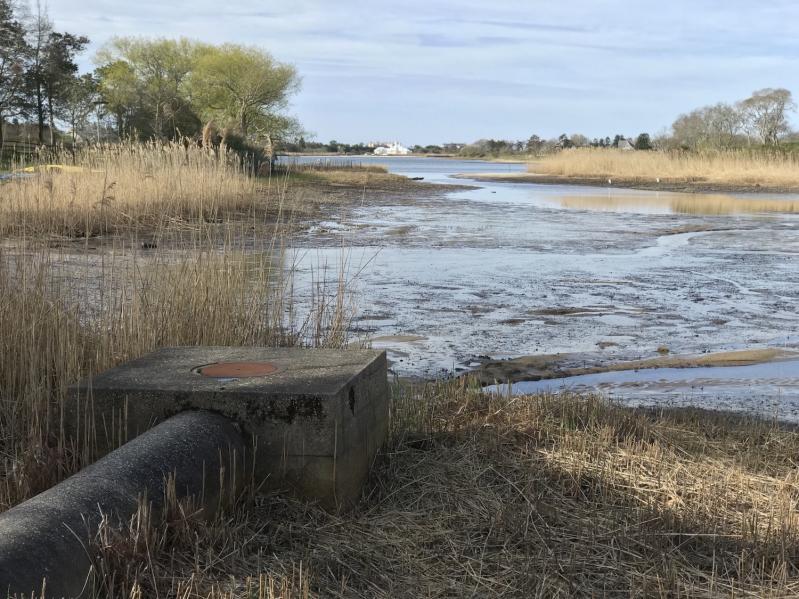The mud flat at the terminus of Cove Hollow Road in East Hampton Village is often occupied by Wilson’s snipe, a secretive bird of bogs; green-winged teal, killdeer, and greater yellowlegs. Somehow they favor this place, despite the presence of a 24-inch pipe that drains untreated stormwater into Georgica Cove. Georgica Pond suffers historically from algae blooms fed by phosphorus and nitrogen loading.
Mellissa Winslow, a senior environmental analyst in the town’s Natural Resources Department, briefed the town board last week on what may be the final design for a $2.1 million project that would treat the stormwater entering the cove from the mile and a half-long, Depression-era, pipe, which was originally constructed to treat farmland runoff. An earlier plan incorporated a small pedestrian passive-use space, with a parking area and educational signage, on the generous acre of land owned by the village, but it was replaced by a no-frills design that leaves the existing footprint of the roadway. A small access path for kayak launching remains from the earlier plan.
“You go there to zone out and have lunch,” said East Hampton Town Supervisor Kathee Burke-Gonzalez. “People don’t exit their cars.”
“This is exactly where we should try to land right now, as far as the town aspect of the project,” said Councilman David Lys. Half of the pipe is in the town’s jurisdiction, and half in the village’s. “The village is supportive of the design. It’s been a pleasure to see the two municipalities work together on this project.”
Accordingly, the focus of the work became treating the stormwater, by making improvements to the pipe running just east of the access road. The pipe will be “daylighted,” or opened to what’s known as a “best management practices” structure.
Ryan Winter of V.H.B. Engineering briefed the board on the drainage issues handled by the pipe; his colleague Andrew Kell discussed the design of a bioswale and water-filtration wetlands.
Water will flow out of a pipe under Cove Hollow Road and exit into a riprap plunge pool, just off the roadway, that will help to remove solids and slow the flow. From there, it will move through a constructed wetland of native plants before reaching another filter, a wire cage of rocks and sand, en route to a shallow wetlands micro pool, whence it seeps into the cove. The bioswale, or rain garden, is designed to treat only an inch and a half of rain, but Ms. Winslow notred that 80 percent or more of contaminants come in the first flush of a storm.
“We’re also looking to upgrade further north, to implement other bioswales to reduce water that is getting to the pipe,” she said.
The cove, especially its southern edge, has been overtaken by invasive phragmites. They will be removed. If allowed to remain, they would grow into the constructed wetland and choke out the native species. (Also, as noted by Councilwoman Cate Rogers, phragmites don’t do much to soak up excess moisture.)
“In the 1930s,” said Councilman Lys, “if they had a drainage issue, they just got it away from where there was a problem and brought it to the water.” As for managing the first inch and a half of the rainstorm, he said it was more than what’s being treated now.
He spoke also of the work being done at the Route 27 rest stop, which will also improve runoff entering the pond. Further, while it’s been a headache for traffic this summer, the State Department of Transportation has worked since last fall to replace the storm drains on Montauk Highway between Wainscott and through East Hampton Village.
“There’s lots of intermunicipal work being done to encapsulate as much water as we can,” said Mr. Lys.
The town has applied for two grants to foot the bill: one for $250,000 from Suffolk County and the other for $500,000 from the state. The remainder will be paid for with funds from the Community Preservation Fund’s water quality improvement fund.
Sara Davison, the outgoing executive director of Friends of Georgica Pond, spoke during the public portion of the meeting, reiterating her support for the project. In April the group had submitted a letter to the village stating that the pipe was “a very large source of contamination.”
Before work can begin, both the State Department of Environmental Conservation and the Army Corps of Engineers will be offered an opportunity to comment further; both have done so already. A permit is required from the D.E.C., and it has yet to be granted.




